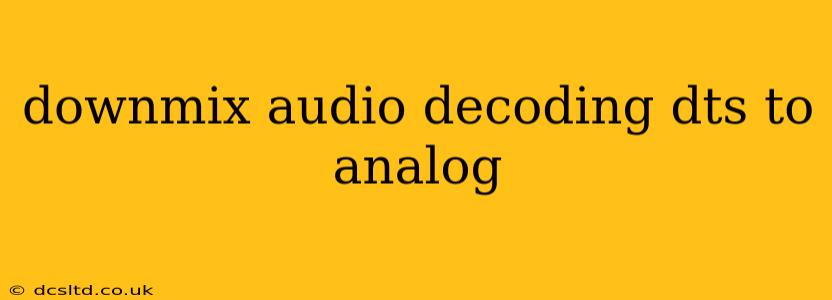Decoding DTS audio and downmixing it to analog output might seem complex, but understanding the process can significantly enhance your home theater or audio setup. This guide breaks down the process, addressing common questions and concerns. Whether you're a seasoned audiophile or a casual listener, this information will help you get the best sound from your DTS sources.
What is DTS Audio?
DTS (Digital Theater Systems) is a competing surround sound format to Dolby Digital. It's known for its high-quality audio and ability to deliver immersive surround sound experiences. Like Dolby Digital, DTS encodes multiple audio channels into a digital stream for transmission or storage. This stream then needs to be decoded and processed to be output as sound.
How Does DTS Audio Downmixing Work?
DTS audio, often encoded in 5.1 (five speakers plus a subwoofer) or even 7.1 surround sound, needs to be converted to a format suitable for your analog audio output devices (like a stereo system). This conversion is called downmixing. The process involves combining the multiple channels into fewer channels, typically stereo (left and right).
Several methods exist for downmixing DTS audio:
-
Matrix Downmixing: This is a common method that uses algorithms to combine the surround channels into the left and right channels. It attempts to preserve the most important audio elements, but some information is inevitably lost. The result is a stereo signal that aims to recreate a sense of spatial audio.
-
Logic-Based Downmixing: This is a more advanced approach that considers the source material. The decoder analyzes the audio signal to understand where sounds are positioned and mixes them accordingly. This often provides better results than matrix downmixing.
-
Downmixing within the AV Receiver/Processor: Modern AV receivers and processors usually handle DTS downmixing internally. They include sophisticated algorithms to ensure a quality stereo output.
What Equipment Do I Need to Downmix DTS to Analog?
The necessary equipment depends on your setup. At a minimum, you need:
- A DTS-capable audio source: This could be a Blu-ray disc player, streaming device, or gaming console capable of playing DTS-encoded content.
- A decoder: This is often integrated into your AV receiver, soundbar, or other audio processing unit. Some older systems may require a separate DTS decoder.
- Analog audio outputs: Your audio source or processor must have analog outputs (typically RCA connectors) to connect to your stereo system.
- A stereo system: This is where the downmixed analog signal will be played.
What are the Different Types of DTS Surround Sound?
DTS offers various surround sound formats, including:
- DTS 5.1: The standard 5.1 surround sound.
- DTS 7.1: An expanded format with more channels for even more immersive sound.
- DTS:X: An object-based audio format, providing more flexibility and precision in sound placement. Downmixing DTS:X generally requires a more sophisticated processor.
- DTS:HD Master Audio: A high-resolution audio codec offering improved audio quality.
The process of downmixing varies slightly depending on the specific DTS format. However, the fundamental principles remain the same.
How Can I Ensure High-Quality Downmixing?
- Use a high-quality AV receiver or processor: A more expensive unit will generally offer better downmixing algorithms and more accurate sound reproduction.
- Proper Speaker Placement: Even with downmixing, good speaker placement for stereo listening will improve the quality of the sound.
- Calibrate Your System: Use an audio calibration tool to optimize the sound output for your specific listening environment.
Does Downmixing Affect Audio Quality?
Yes, some audio quality loss is inevitable during downmixing. The process inherently reduces the number of audio channels, resulting in some information loss. However, advanced algorithms minimize this loss, leading to a surprisingly good stereo experience. The impact of quality loss depends heavily on the downmixing method and the equipment used.
Why Might My Downmixed DTS Audio Sound Bad?
Poor sound quality after downmixing could be due to several factors:
- Low-quality equipment: Using a budget AV receiver with poor downmixing algorithms will result in subpar sound.
- Incorrect settings: Ensure your AV receiver is correctly configured for DTS decoding and downmixing to stereo.
- Faulty connections: Check all cables and connections to ensure a clean signal path.
- Room acoustics: Poor room acoustics can significantly impact audio quality, regardless of the source or processing.
By understanding the fundamentals of DTS audio decoding and downmixing, you can optimize your audio setup for the best possible listening experience. Remember that higher-quality equipment and proper configuration are key to achieving excellent sound even after downmixing.
